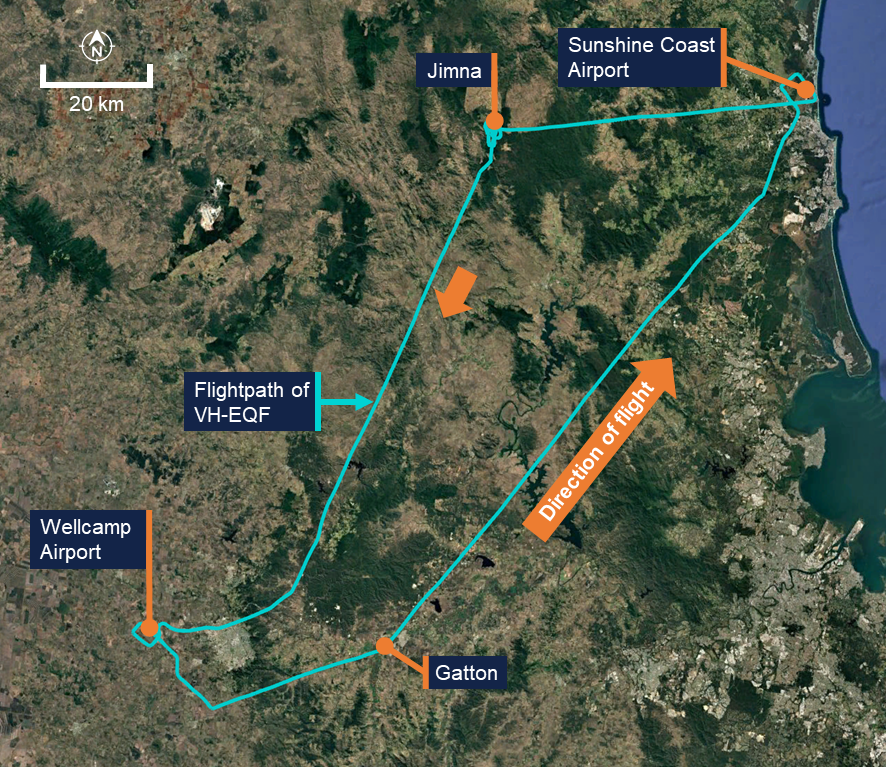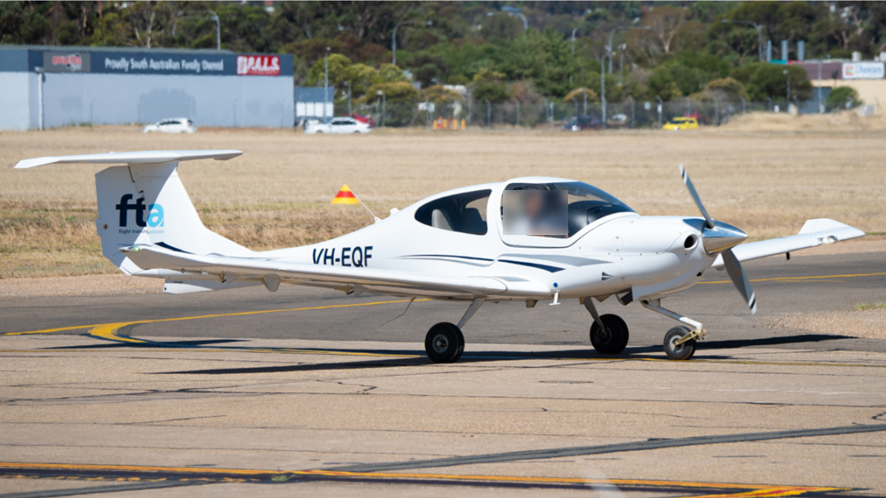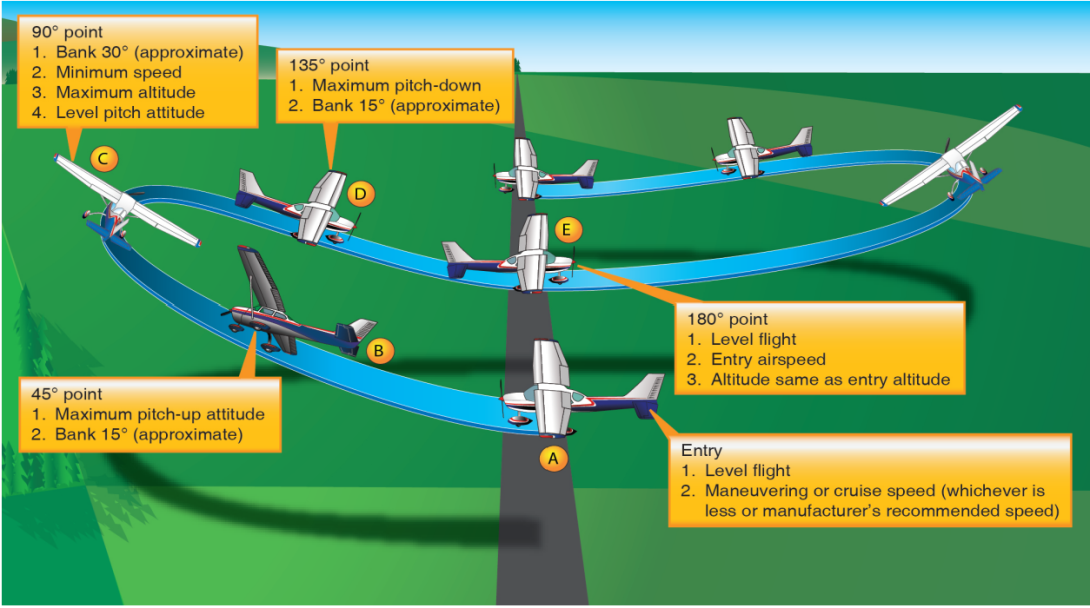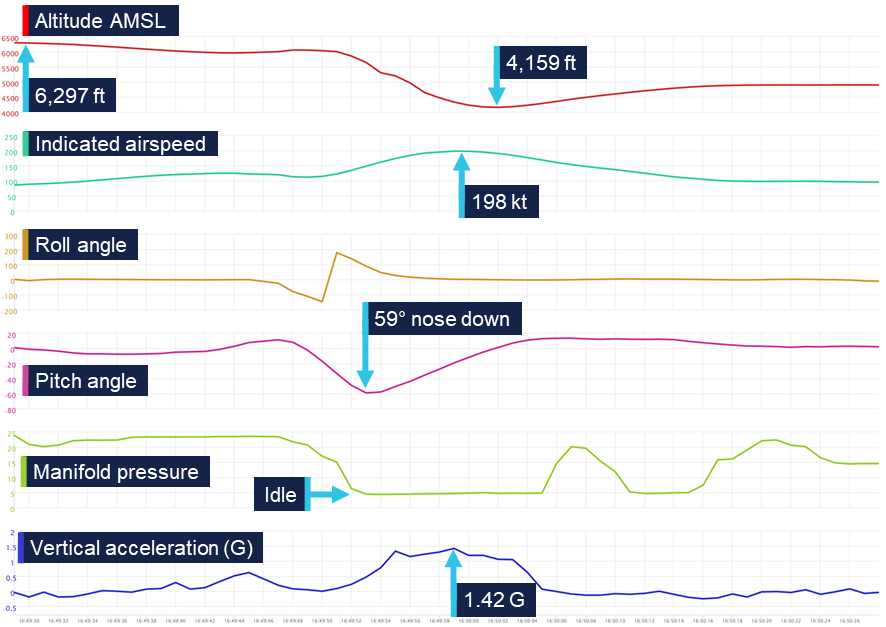Investigation summary
What happened
At 1520 on 12 February 2025, an instructor and student departed from Brisbane West Wellcamp Airport, Queensland for a training flight in a Diamond DA40 aircraft, registered VH-EQF and operated by Flight Training Adelaide.
At 1649, as the instructor and student were conducting stall and upset recovery training at an altitude of about 6,300 ft above mean sea level, the instructor took control of the aircraft. Acting on impulse and without providing a briefing to the student, the instructor attempted a wingover.
During the attempted wingover, the bank angle quickly exceeded the aircraft’s 60° bank angle limitation before continuing beyond inverted and the aircraft’s pitch became steeply nose down. During the recovery, the speed increased beyond the aircraft’s never exceed airspeed (VNE). The flight was completed without further incident and the aircraft landed at Wellcamp at 1726.
What the ATSB found
The ATSB found that the instructor attempted a wingover manoeuvre for which they had not been trained. During the manoeuvre, the aircraft was rolled through 360°, exceeding the aircraft's 60° bank angle limit and the aircraft exceeded VNE by 20 knots.
What has been done as a result
Following the incident, Flight Training Adelaide issued an internal notice to instructors and students restricting the conduct of non-training syllabus manoeuvres. The notice advised that prior to such manoeuvres being conducted, prior permission must be obtained from the Head of Operations or Deputy Head of Operations.
A presentation was also provided to instructors on the importance of personal limitations and effective decision‑making to ensure safe operations.
Safety message
This incident underlines that pilots should not attempt unfamiliar manoeuvres without first receiving appropriate training. Effective training reduces the likelihood of mishandling and also prepares a pilot to respond appropriately should a manoeuvre deviate from the intended flightpath.
While the aircraft was not damaged during this incident, it is important that all exceeded limitations are entered onto the maintenance release and reported quickly to ensure the aircraft is inspected before further flight. This will ensure that other pilots are not exposed to the risk of operating a damaged aircraft.
The investigation
The occurrence
At 1520 local time on 12 February 2025, an instructor and student departed from Brisbane West Wellcamp Airport, Queensland for a training flight in a Diamond DA40 aircraft, registered VH-EQF and operated by Flight Training Adelaide. The flight intended to track via Gatton and Sunshine Coast Airport before conducting stall and upset recovery training near Jimna and then returning to Brisbane West Wellcamp Airport (Figure 1).
Figure 1: Overview of flight

Source: Google Earth, annotated by the ATSB
At 1649, as the instructor and student were conducting the stall and upset recovery training at an altitude of about 6,300 ft above mean sea level (AMSL), the instructor took control of the aircraft. Acting on impulse, and without providing a briefing to the student, the instructor attempted a wingover manoeuvre (see the section titled Wingover). The instructor pitched the aircraft down to increase speed before pitching the aircraft up and beginning a rapid left roll at 120 kt indicated airspeed. At the same time, the instructor began reducing engine power.
The roll quickly exceeded the aircraft’s 60° bank angle limitation (see the section titled Aircraft details) and the instructor continued applying a roll input. As the roll angle exceeded 90°, the pitch angle dropped below the level attitude and the airspeed began increasing. The aircraft then rolled beyond inverted, the aircraft’s pitch became steeply nose down, and the instructor reduced power to idle to begin recovery from the dive.
The instructor was aware of the risk of exceeding the aircraft’s maximum G[1] limitation and so slowly increased the pitch attitude as speed continued increasing. At 1649:56, the speed increased beyond the never exceed speed[2] of 178 kt, and 3 seconds later reached a maximum of 198 kt. The instructor continued the recovery from the dive and at 1650:02, the aircraft reached a minimum recorded altitude of 4,159 ft AMSL before a climb was commenced. At 1650:04, the speed reduced below 178 kt.
The instructor then climbed the aircraft back up to an altitude of about 5,000 ft and the student advised the instructor of the speed exceeding 178 kt. The instructor then conducted an inspection of the airframe visible from the cabin and did not identify any defects. They then handed control of the aircraft back to the student to continue the flight. About 3 minutes after the incident, another stall recovery training manoeuvre was completed. The rest of the flight was conducted normally, with the student flying the aircraft. At 1726 the aircraft landed at Wellcamp.
The instructor reported that, after landing, they thought about the attempted wingover, but also had to focus on preparation for another flight. The instructor confirmed that no bookings were scheduled for the aircraft that evening, however they did not mark the aircraft as unavailable or endorse its maintenance release at that time. The instructor then completed an evening of night flying in another aircraft. Later at home they recognised that the incident needed to be reported to the operator and intended to do so the next morning.
Early the next morning, the instructor marked the aircraft as unserviceable in the operator’s booking system. The instructor also contacted the operator’s training manager and had the aircraft’s maintenance release endorsed to prevent further flights.
Context
Instructor and student details
The instructor held a commercial pilot licence (aeroplane) and class 1 aviation medical certificate. The instructor had 930 hours of flying experience, of which 900 hours were in the DA40, with 120 hours accrued in the previous 90 days.
The instructor had completed spin recovery training but had not completed any other aerobatics training and did not hold an aerobatics endorsement. The instructor had previously been in a DA40 where a wingover had been demonstrated, but the instructor had not received training in conduct of the manoeuvre.
The student held a student pilot licence (aeroplane) and class 1 aviation medical certificate and had about 125 hours of flying experience.
The ATSB found no indicators that the instructor or student were experiencing a level of fatigue known to adversely affect performance.
Aircraft details
The Diamond Aircraft Industries DA40 is a 4-seat, low-wing, fixed-tricycle-undercarriage aircraft with a single reciprocating engine driving a variable pitch 2-bladed propeller (Figure 2). The never exceed speed (VNE) of 178 kt was not to be exceeded for any operation in the aircraft.
Figure 2: VH-EQF

Source: Mitch Coad, modified by ATSB
The DA40 was certified to operate in the normal and utility categories and was not certified for aerobatics. The utility category had a maximum weight limit of 980 kg. For all operations above that weight, the aircraft could be operated in the normal category only. At the time of the incident, the aircraft weighed 1,111 kg.
The aircraft’s airplane flight manual stated that when operated in the normal category, the maximum positive load factor was 3.8 G and approved manoeuvres were limited to:
1) All normal flight manoeuvres;
2) Stalling (with the exception of dynamic stalling); and
3) Lazy Eights, Chandelles, as well as steep turns and similar manoeuvres, in which an angle of bank of not more than 60° is attained.
The manual also cautioned that aerobatics, spinning, and flight manoeuvres with more than 60° of bank were not permitted when operating in the normal category. When operating the aircraft in the utility category, the bank angle limitation was 90°. All other manoeuvre limitations were unchanged.
Wingover
The wingover manoeuvre involves a combination of pitching up and banking of the aircraft to effect a change in heading. It can be conducted at varying angles of bank and pitch to turn through different angles of heading change. For a typical 180° heading change wingover, the aircraft is descended slightly to accelerate before the aircraft is pitched up to commence a climb, followed by a left or right turn. During the turn, the pitch is reduced below level to commence descending. The angle of bank is then reduced to exit the manoeuvre in the opposite direction, at the same altitude as commencement and with wings level.
A lazy eight is a pair of wingovers of 180° heading change made in succession and in opposite directions. The resulting flightpath resembles a horizontal figure of 8 (Figure 3).
Figure 3: Lazy eight manoeuvre

Source: United States Federal Aviation Administration Airplane Flying Handbook
Aerobatics
The Civil Aviation Safety Authority defined aerobatics as:[3]
aerobatic manoeuvres, for an aircraft, means manoeuvres of the aircraft that involve:
(a) bank angles that are greater than 60°; or
(b) pitch angles that are greater than 45°, or are otherwise abnormal to the aircraft type; or
(c) abrupt changes of speed, direction, angle of bank or angle of pitch.
Incident reporting and post-incident inspection
Following the flight, the instructor identified that the aircraft was not scheduled to be used further that evening. However, the aircraft’s maintenance release was not endorsed, and the aircraft was not made unavailable until early the following morning.
Upon being advised of the exceedance, the aircraft manufacturer required that the aircraft undergo a minimum of a major structural inspection. This inspection found that the aircraft was not damaged during the incident.
Meteorology and terrain
The incident manoeuvre was conducted in clear visual meteorological conditions.
At 1700, 11 minutes after the incident, the Bureau of Meteorology (BoM) automatic weather station at Kingaroy Airport, 63 km west of the incident recorded the wind as 4 kt from 060° magnetic. There was no recorded cloud and visibility was greater than 10 km.
The ground level elevation beneath the aircraft during the incident was about 1,400 to 1,650 ft AMSL.
Recorded data
The aircraft was equipped with Garmin G1000 instrumentation that recorded the incident (Figure 4).
Figure 4: Recorded data from VH-EQF

Altitudes are above mean sea level. Source: ATSB
The manoeuvre commenced at 1649:29 with a slight descent and acceleration from an altitude of 6,297 ft AMSL. The left roll then commenced at 1649:47 at an airspeed of 120 kt, a pitch angle of 11° nose up and the bank angle reached 79° left one second later. At the same time engine power began reducing.
A second later, at 1649:49, the pitch attitude reduced below the level attitude and the bank angle reached 111° left before the aircraft rolled beyond inverted (180° roll) 2 seconds later. At that time, the pitch angle was 33° nose down and the engine power was reduced to idle as the aircraft accelerated through 122 kt.
At 1649:53, 6 seconds after the roll commenced, the aircraft had rolled through 271° and was now in a right 89° bank, and the pitch angle had reached 59° nose down, with the speed rapidly increasing past 149 kt. Three seconds later, the speed increased beyond the never exceed speed (VNE) of 178 kt and continued increasing. At 1649:56, with the nose still pitched down 19° and the wings now level, the speed reached a maximum of 198 kt. At the same time, the recorded G level increased to a maximum of 1.42 G. Speed then began to reduce and 3 seconds later, the aircraft reached a minimum recorded altitude of 4,159 ft AMSL, about 2,600 ft above the ground. Another 5 seconds later, at 1650:04, the speed reduced back below VNE.
Safety analysis
During stall and upset recovery training, the instructor took control of the aircraft and, without briefing the student, attempted a wingover. A wingover, being essentially half of a lazy eight, was a permitted manoeuvre in the aircraft provided the angle of bank did not exceed 60° (flight manual limitation) and the pitch angle remained less than 45° (aerobatic definition limitation). However, the instructor had not been trained in this manoeuvre and did not increase pitch sufficiently before applying a rapid roll input that quickly exceeded the aircraft’s bank angle limitation. As the aircraft rolled, it began pitching down rapidly and as the roll passed beyond inverted, the pitch angle became steeply nose down.
The instructor responded to the nose down attitude by reducing power to idle but then prioritised minimising G load during the recovery from the dive. Although the instructor achieved this aim, with a maximum recorded G value of 1.42 G, well below the 3.8 G maximum, by not increasing pitch more positively, the aircraft’s speed increased rapidly and significantly exceeded the never exceed speed. Exceeding this limitation risked structural damage or failure.
Findings
|
ATSB investigation report findings focus on safety factors (that is, events and conditions that increase risk). Safety factors include ‘contributing factors’ and ‘other factors that increased risk’ (that is, factors that did not meet the definition of a contributing factor for this occurrence but were still considered important to include in the report for the purpose of increasing awareness and enhancing safety). In addition ‘other findings’ may be included to provide important information about topics other than safety factors. These findings should not be read as apportioning blame or liability to any particular organisation or individual. |
From the evidence available, the following findings are made with respect to the airframe overspeed involving Diamond DA 40, VH-EQF, 63 km east of Kingaroy Airport, Queensland on 12 February 2025.
Contributing factors
- During a training flight, the instructor attempted a wingover manoeuvre for which they had not been trained.
- During the manoeuvre, the aircraft pitched steeply nose down and was rolled through 360°, exceeding the aircraft's 60° bank angle limit. During the subsequent recovery, the aircraft exceeded its never exceed airspeed by 20 knots.
Safety actions
Proactive safety action by Flight Training Adelaide
| Action number: | AO-2025-007-PSA-01 |
| Action organisation: | Flight Training Adelaide |
Flight Training Adelaide issued an internal notice to instructors and students restricting the conduct of non-training syllabus manoeuvres. The notice advised that prior to such manoeuvres being conducted, prior permission must be obtained from the Head of Operations or Deputy Head of Operations.
A presentation was also provided to instructors on the importance of personal limitations and effective decision‑making to ensure safe operations.
Sources and submissions
Sources of information
The sources of information during the investigation included:
- the instructor and student
- Flight Training Adelaide
- Civil Aviation Safety Authority
- the aircraft manufacturer
- recorded data from VH-EQF.
References
Submissions
Under section 26 of the Transport Safety Investigation Act 2003, the ATSB may provide a draft report, on a confidential basis, to any person whom the ATSB considers appropriate. That section allows a person receiving a draft report to make submissions to the ATSB about the draft report.
A draft of this report was provided to the following directly involved parties:
- Flight Training Adelaide
- the instructor and student
- Civil Aviation Safety Authority
Submissions were received from:
- Flight Training Adelaide
- the instructor and student
The submissions were reviewed and, where considered appropriate, the text of the report was amended accordingly.
Purpose of safety investigationsThe objective of a safety investigation is to enhance transport safety. This is done through:
It is not a function of the ATSB to apportion blame or provide a means for determining liability. At the same time, an investigation report must include factual material of sufficient weight to support the analysis and findings. At all times the ATSB endeavours to balance the use of material that could imply adverse comment with the need to properly explain what happened, and why, in a fair and unbiased manner. The ATSB does not investigate for the purpose of taking administrative, regulatory or criminal action. TerminologyAn explanation of terminology used in ATSB investigation reports is available here. This includes terms such as occurrence, contributing factor, other factor that increased risk, and safety issue. Publishing informationReleased in accordance with section 25 of the Transport Safety Investigation Act 2003 Published by: Australian Transport Safety Bureau © Commonwealth of Australia 2025
Ownership of intellectual property rights in this publication Unless otherwise noted, copyright (and any other intellectual property rights, if any) in this report publication is owned by the Commonwealth of Australia. Creative Commons licence With the exception of the Commonwealth Coat of Arms, ATSB logo, and photos and graphics in which a third party holds copyright, this report is licensed under a Creative Commons Attribution 4.0 International licence. The CC BY 4.0 licence enables you to distribute, remix, adapt, and build upon our material in any medium or format, so long as attribution is given to the Australian Transport Safety Bureau. Copyright in material obtained from other agencies, private individuals or organisations, belongs to those agencies, individuals or organisations. Where you wish to use their material, you will need to contact them directly. |
[1] G load: the nominal value for acceleration. In flight, G load represents the combined effects of flight manoeuvring loads and turbulence and can have a positive or negative value.
[2] VNE (Never Exceed Speed): the speed limit that may not be exceeded at any time. The calculation of this speed is driven by structural or aerodynamic limitations; however, control system flutter is typically one limitation that factors heavily into the calculation of VNE.
[3] Civil Aviation Safety Regulations Part 91 – Dictionary, Part 1 - Definitions


